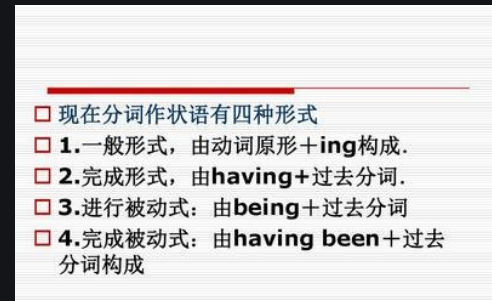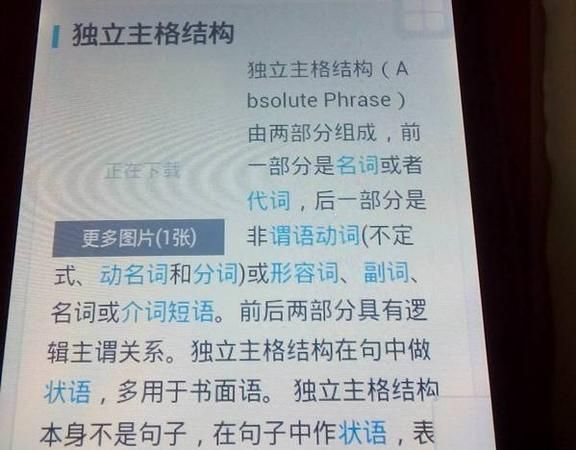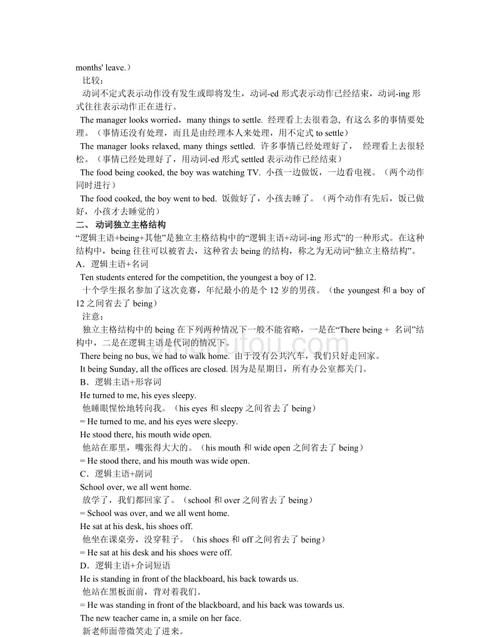本文目录
独立主格8种基本句型例句和非谓语
独立主格8种基本句型例句有如下:
1、“名词/代词+不定式”结构
由不定式构成的独立主格 结构往往表示还未发生的动作或状态,在句中常作原因状语,偶尔作条件状语。例如:
His friends to come tonight,he is busy preparing the dinner.
他的朋友今晚要来,他正忙着准备晚餐。
No one to wake me up,I might be late for the first class.
如果没人叫醒我,我会错过第一节课的。
2、“名词/代词+现在分词”结构
现在分词表示前面的名词或代词主动进行的动作或状态等。“独立结构”中的being或 having been有时可以省去,这样就成了无动词分句或过去分词分句。例如:
The man lay there, his hands trembling.
那个男子躺在那儿,双手在颤抖。
So many students being absent, the meeting had to be put off.
那么多学生没到,会议不得不推迟。
His homework having been done, Tom went to sleep.
做完作业后,汤姆睡着了。
3、“名词/代词+过去分词”结构
过去分词表示前面的名词或代词被动完成的动作或所处的一种状态。例如:
he boy lay on his back, his hands crossed under his head.
男孩仰卧着,双手交叉放在头下。
4、“名词/代词+名词”结构
名词一般做前面名词或代词的同位语。例如:
Many people joined in the work, some of them women and children.
许多人参加了这项工作,其中有些是妇女和儿童。
He fought the tiger,a stick his only weapon.
他与老虎搏斗,那是他唯一的武器。

5、“名词/代词+形容词”结构
形容词(短语)说明前面名词或代词的性质,状态,原因等。例如:
The floor wet and slippery, we had to stay outside for a while.
地面很湿,我们只好在外面呆一会儿。
I heard that she got injured in the accident, my heart full of sorry.
我听说她在这场事故中受伤了,心中充满担忧。(形容词,表伴随)。
这两个句子也可以看成是省略了being,如果加上,就变成了现在分词分句。
6、“逻辑主语+副词”结构
副词说明前面名词或代词的状态。例如:
The meeting over, we all went home.
会议结束,我们都回家了。
7、“逻辑主语+介词短语”结构
介词短语说明伴随前面名词或代词的方式或者状态。例如:
The teacher came in, a book under his arm.
老师在他的胳膊下夹着一本书进来了。
The hunter entered the forest, gun in hand.
那位猎人手里提着枪走进了树林。
Nobody at home, the thief took a lot of things away.
家里很多东西都没人拿走。
8、“with/without”引导的独立主格结构
A woman got on the bus with a baby around her arms.
一位妇女抱着一个婴儿上了公共汽车。
动词ing的独立主格结构
1)独立主格结构的逻辑主语与句子的主语不同,它独立存在。
2)名词或代词与后面的分词,形容词,副词,不定式,介词等是主谓关系。
3)独立主格结构一般有逗号与主句分开。
举例:
The
test
finished,
we
began
our
holiday.
=
When
the
test
was
finished,
we
began
our
holiday.
考试结束了,我们开始放假。
The
president
assassinated,
the
whole
country
was
in
deep
sorrow.
=
After
the
president
was
assassinated,
the
whole
country
was
in
deep
sorrow.
总统被谋杀了,举国上下沉浸在悲哀之中。
Weather
permitting,
we
are
going
to
visit
you
tomorrow.
如果天气允许,我们明天去看你。
This
done,
we
went
home.
工作完成后,我们才回家。
The
meeting
gone
over,
everyone
tired
to
go
home
earlier.
会议结束后,每个人都想早点回家。
He
came
into
the
room,
his
ears
red
with
cold.
他回到了房子里,耳朵冻坏了。
He
came
out
of
the
library,
a
large
book
under
his
arm.
他夹着本厚书,走出了图书馆
2.
With的复合结构作独立主格
表伴随时,既可用分词的独立结构,也可用with的复合结构。
with
+名词(代词)+现在分词/过去分词/形容词/副词/不定式/介词短语
举例:
He
stood
there,
his
hand
raised.
=
He
stood
there,
with
his
hand
raise.
典型例题
The
murder
was
brought
in,
with
his
hands
___
behind
his
back。
A.
being
tied
B.
having
tied
C.
to
be
tied
D.
tied
答案D.
with
+名词(代词)+分词+介词短语结构。当分词表示伴随状况时,其主语常常用with来引导。由于本句中名词"手"与分词"绑"是被动关系,因此用过去分词,选D.
注意:
1)
独立主格结构使用介词的问题:
当介词是in时,其前后的两个名词均不加任何成分(如物主代词或冠词),也不用复数。但
with
的复合结构不受此限制
A
robber
burst
into
the
room,
knife
in
hand.
(
hand前不能加his)。
2)
当表人体部位的词做逻辑主语时,及物动词用现在分
词,不及物动词用过去分词。
He
lay
there,
his
teeth
set,
his
hand
clenched,
his
eyes
looking
straight
up.
典型例题:
Weather___,
we'll
go
out
for
a
walk.
A
permitted
B
permitting
C
permits
D
for
permitting
答案B.
本题中没有连词,它不是复合句,也不是并列句。
句中使用了逗号,且we
小写,可知其不是两个简单句。能够这样使用的只有独立主格或with的复合结构。据此判断,本句中使用的是独立结构,
其结构为:名词+分词。
由于permit在这里翻译为'天气允许',表主动,应用现在分词,故选B。
如果不会判断独立结构作状语的形式,不妨将句子改为条件句,例如本句改为If
weather
permits,
we'll
go
out
for
a
walk.
然后将if
去掉,再将谓语动词改为非谓语动词即可。

独立主格结构长难句
独立主格结构很重要,考试必考的,你要好好学啊。
独立主格的结构:独立主格大体有以下几种结构:
1.名词(代词)+现在分词、过去分词;
2.名词(代词)+形容词;
3.名词(代词)+副词;
4.名词(代词)+不定式;
5.名词(代词)+介词短语构成。
再给几个例句吧
1.The coward was backing, his face being deathly pale toward another room.(那个胆小鬼向另一个房间退去,脸色煞白。)
(而实际上,上面我们举的所有例子都是第一种结构。)
2. The food delicious, I was full.(食物非常可口,我也很饱了。)
3. This little excitement over, nothing was to be done but to return to a steadfast gaze at my mute companion.(一阵小小的兴奋过后,除了再去死死地盯着我的哑伴外,别无它事可干了。)
4. I to go to New York, he asked me not.(我要去纽约,他却要我别去)
5. The mayor of Hiroshima strode at a leisure pace toward the puzzled journalist, a bunch of flowers in his hands.(广岛市市长双手捧着一束鲜花,迈着方步走向那个迷惑不解的记者。)
另外,最常见的独立主格结构是with引导的独立主格结构。比如:Our vicar went to see what was happening with a torch in his arm. 这种用法中的with不表达什么意义,因而常可省略。表示伴随情况时,既可用分词的独立结构,也可用with的复合结构:with +名词(代词)+现在分词/过去分词/形容词/副词/不定式/介词短语。例如:
He stood there, his hand raised. = He stood there, with his hand raise.他举手着站在那儿。
The murderer was brought in, with his hands ___ behind his back。
A. being tied B. having tied C. to be tied D. tied
答案D. with +名词(代词)+分词+介词短语结构。当分词表示伴随状况时,其主语常常用with来引导。由于本句中名词"手"与分词"绑"是被动关系,因此用过去分词,选D.
*with引导的用法是最重要的用法。
三、独立主格结构的用法
独立主格结构在句中一般作状语,表示时间、条件、原因、伴随状况等。
1.作时间状语
1)My shoes removed, I entered a low-ceilinged room, treading cautiously on the soft tatami matting.=After my shoes were removed, I entered a low-ceilinged room,treading cautiously on the soft tatami matting.(我脱掉鞋子后,走进一间屋顶很低的房间,小心翼翼地踩在柔软的塌塌米垫子上。)
2.作条件状语
Weather permitting, they will go on an outing to the beach tomorrow.=If weather permits, they will go on an outing to the beach tomorrow.(如果天气允许的话,他们将在明天组织一次海滨小游。)
3.作原因状语
The storm drawing near, we had to put off our plan.=As the storm drew near, we had to put off our plan.(由于暴风雨临近,我们只好放弃计划)
4.作伴随状语
I took out my book, open it, and drawing pictures in it, my teacher looking angry.(老师愤怒地看着我拿出书,打开它,然后开始在上面画画。)

英语独立主格句子例句
一、独立主格结构的概念及基本构成形式
独立主格结构(the absolute structure)是由名词或代词加上分词或分词短语构成的一种独立结构,用于修饰整个句子,而不是一个词或词组。独立主格结构中的名词或代词与其后的分词或分词短语构成逻辑上的主谓关系。这种结构与主句不发生句法上的联系,独立主格结构的位置相当灵活,可置于主句前、主句末或主句中,常由逗号将其与主句分开。需特别注意的是,独立主格结构与主句之间不能使用任何连接词。例如:
1)Night enshrouding the earth,nobody could make out what the dark mass was from a distance.(黑夜笼罩大地,谁也看不清远处黑压压的一片是什么东西。)
独立主格结构多用于书面语,尤其是描述性语言中,在口语和非正式文体中,一般用从句或两个句子来代替。例如,上述例句可变为:
二、独立主格结构的特殊构成形式
独立主格结构除上述基本构成形式,即名词/代词+分词(短语)外,还有如下特殊构成形式。
1.名词+介词短语
1)The mayor of Hiroshima strode at a leisure pace toward the puzzled journalist,a bunch of flowers in his hands.(广岛市市长双手捧着一束鲜花,迈着方步走向那个迷惑不解的记者。)
2.名词+形容词(短语)
1)The Trojans asleep,the Greek soldiers crept out of the hollow wooden horse.(特洛伊人睡着了,于是希腊士兵从中空的木马里悄悄爬了出来。)
3.名词+副词
1)This little excitement over,nothing was to be done but to return to a steadfast gaze at my mute companion.(一阵小小的兴奋过后,除了再去死死地盯着我的哑伴外,别无它事可干了。)
此外,with常常用在独立主格结构前,构成介词短语作状语。这种用法中的with不表达什么意义,因而常可省略。请看例句:
1)With a revolver in his right hand, Johnny hurled his muscular body against the door and smashed it down with a crash.(约翰尼右手拿着左轮手枪,健壮的身体猛扑在门上,轰隆一声把门撞开了。)
三、独立主格结构的用法
独立主格结构在句中一般作状语,表示时间、条件、原因、伴随状况等。
1.作时间状语
1)My shoes removed,I entered a low-ceilinged room,treading cautiously on the soft tatami matting.=After my shoes were removed, I entered a low-ceilinged room,treading cautiously on the soft tatami matting.(我脱掉鞋子后,走进一间屋顶很低的房间,小心翼翼地踩在柔软的塌塌米垫子上。)
2.作条件状语
1)Weather permitting,they will go on an outing to the beach tomorrow.=If weather permits,they will go on an outing to the beach tomorrow.(如果天气允许的话,他们将在明天组织一次海滨小游。)
3.作原因状语
1)The storm drawing near,the navvy decided to call it a day.=Since the storm was drawing near,the navvy decided to call it a day.(由于暴风雨即将来临,那个挖土小工决定收工。)
4.作伴随状语
1)I took my ticket,and marched proudly up the platform,with my cheeses,the people falling back respectfully on either side.=I took my ticket,and marched proudly up the platform,with my cheeses,and the people fell back respectfully on either side.(我拿着车票还有我的奶酪,雄赳赳气昂昂地跨步走向月台。人们似乎很尊敬我,纷纷向两边退去。)
还可以看这个PPT文档: ***/view/7fb63224dd36a32d7375810a.html

以上就是关于独立主格做伴随状语例句,独立主格8种基本句型例句和非谓语的全部内容,以及独立主格做伴随状语例句 的相关内容,希望能够帮到您。

